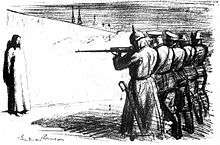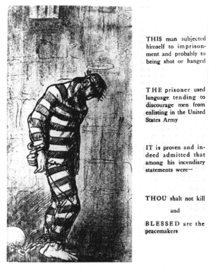Peace churches
Peace churches are Christian churches, groups or communities advocating Christian pacifism or Biblical nonresistance. The term historic peace churches refers specifically only to three church groups among pacifist churches—Church of the Brethren; Religious Society of Friends (Quakers); and Mennonites, including the Amish, Old Order Mennonite, and Conservative Mennonites—and has been used since the first conference of the peace churches in Kansas in 1935.[1][2][3][4][5]
The definition of "peace churches" is sometimes expanded to include Christadelphians (from 1863) and others who did not participate in the conference of the "historic peace churches" in Kansas in 1935.[6] The peace churches agree that Jesus advocated nonviolence. Whether physical force can ever be justified, either in defending oneself or others, remains controversial. Many believers adhere strictly to a moral attitude of nonresistance in the face of violence. But these churches generally do concur that violence on behalf of nations and their governments is contrary to Christian morality.
History


Among all Christian denominations, there have always been groups of members who advocate nonviolence, but certain churches have consistently supported it since their foundation. Besides the three historic peace churches, they include the Amish,[7] Old Order Mennonites, Conservative Mennonites, Hutterites,[8] Old German Baptist Brethren,[9] Old Order River Brethren,[10] the Brethren in Christ,[11][12] and others in the Anabaptist tradition; Doukhobors,[13] Dunkard Brethren,[14][15] Dukh-i-zhizniki,[16] Bruderhof Communities,[17] Schwenkfelders,[18] Moravians,[19] the Shakers,[20] and even some groups within the Pentecostal movement.[21] The largest Pentecostal church, the Assemblies of God, abandoned pacifism around the time of the Second World War.[22][23] These groups have disagreed, both internally and with each other, about the propriety of non-combatant military roles, such as unarmed medical personnel, or performing non-battlefield services that assist nations in wartime, such as manufacturing munitions. One position might argue that Jesus would never object to helping people who are suffering, while another might object that doing so contributes indirectly to violence by freeing other people to engage in it.
At one time, active membership in and acceptance of the beliefs of one of the peace churches was required for obtaining conscientious objector status in the United States, and hence exemption from military conscription, or for those already in the military, honorable discharge. But after a series of court rulings, this requirement was dropped. In the USA, one may now claim conscientious objector status based on a personal belief system that need not be Christian, nor even based on religion.[24]
Peace churches, especially those with sufficient financial and organizational resources, have attempted to heal the ravages of war without favoritism. This has often aroused controversy, as when the Quakers sent large shipments of food and medicine to North Vietnam during the Vietnam War, and to U.S.-embargoed Cuba. The American Friends Service Committee and the Mennonite Central Committee are two charitable denominational agencies set up to provide such healing.
In the 1980s, the Quakers, Brethren, and Mennonites came together to create Christian Peacemaker Teams, an international organization that works to reduce violence and systematic injustice in regions of conflict.[25][26] This was motivated by the desire for Christians to take peacemaking as seriously as soldiers and governments take war-making.[27]
Other Christian pacifist groups
Christadelphians, 1863
The Christadelphians are one of only a small number of churches whose identity as a denomination is directly linked to the issue of Christian pacifism.[28] Although the grouping which later took the name "Christadelphian" had largely separated from the Campbellite movement in Scotland and America after 1848, it was conscription in the American Civil War which caused their local church in Ogle County, Illinois to register as conscientious objectors in 1863 under the name "Christadelphians."[29] When the First World War was imminent Christadelphians in the British Empire took the same stance, though frequently faced military tribunals. During the Second World War Christadelphians were exempted and performed civil work – though some of the small number of Christadelphians in Germany were imprisoned and one executed.[30] The position was maintained through the Korean War, Vietnam War and today.[31][32]
Seventh-day Adventist Church, 1867
Adventists had sought and obtained exemption as conscientious objectors in 1864, and the Seventh-day Adventist Church from 1914 has a long history of noncombatancy service within and outside the military.[33] Though some church members choose combat, the church stands by its official position, which dates to a resolution made in 1867.[34]
Churches of God (7th day)
The different groups evolving under the name Church of God (7th day) stand opposed to carnal warfare, based on Matthew 26:52; Revelation 13:10; Romans 12:19–21. They believe the weapons of their warfare to not be carnal but spiritual (II Corinthians 10:3–5; Ephesians 6:11–18).[35][36]
Partially pacifist groups
Community of Christ
Although non-credal and not explicitly pacifist, the Community of Christ (formerly known as the Reorganized Church of Jesus Christ of Latter Day Saints) is emerging as an international peace church through such ministries as the Community of Christ International Peace Award, the Daily Prayer for Peace, and resources to support conscientious objection to war.[37][38][39] However, in the United States and worldwide, many church members are active in military service and the church provides active duty chaplaincy for outreach and ministry to military personnel.
Churches of Christ
Once containing a relatively large nonviolence faction, Churches of Christ are now more conflicted. Contemporary Churches of Christ, especially those that hold with the teachings of David Lipscomb, tend toward pacifist views.[40] This means that they believe that the use of coercion and/or force may be acceptable for purposes of personal self-defense but that resorting to warfare is not an option open to Christians.
Fellowship of Reconciliation
As noted above, there are peace groups within most mainstream Christian denominations. The Fellowship of Reconciliation was set up as an organization to bring together people in these groups and members of the historic peace churches. In some countries, e.g. the United States, it has broadened its scope to include members of other religions or none, and people whose position is not strictly for nonviolence. However, in other countries (e.g., the United Kingdom) it remains essentially an organization of Christian nonviolence.[41]
See also
- American Friends Service Committee
- Anglican Pacifist Fellowship
- Baptist Peace Fellowship of North America
- Catholic Worker Movement
- Center on Conscience & War
- Christian pacifism
- Christianity and violence
- Civilian-based defense
- Civilian Public Service
- Conscription
- Diane Drufenbrock
- Doukhobors
- Jewish Peace Fellowship
- List of pacifist faiths
- List of peace activists
- Martin Luther King
- Mennonite
- Nonconformism
- Nonresistance
- Nonviolence
- Pacifism
- Pax Christi
- Plain people
- Religious Freedom Peace Tax Fund Act
- Southern Christian Leadership Conference (SCLC)
- Leo Tolstoy
- John Howard Yoder
References
- ↑ Concise Encyclopedia of Amish, Brethren, Hutterites, and Mennonites p6 Donald B. Kraybill – 2010 "In 1935, BRETHREN, Mennonites, and Quakers met in North Newton, Kansas, for a conference on peace. The term HISTORIC PEACE CHURCHES was developed at this conference in order to distinguish between the groups' biblically based peaceful ..."
- ↑ The Brethren encyclopedia 1983 p608 "The American Civil War brought the peace churches together in combined appeals to government, both in the North and in ... This conference used the term historic peace churches as more acceptable to Mennonites than the term pacifist churches because the latter connoted theological liberalism. Called without prior agenda, the three-day meeting concluded with "
- ↑ Mark Matthews Smoke jumping on the Western fire line: conscientious objectors p36 – 2006 "CHAPTER TWO The Historic Peace Churches – The three historic peace churches that united to lobby for reforming the treatment of conscientious objectors during World War II shared many religious beliefs, but they also differed in many "
- ↑ Speicher, Sara and Durnbaugh, Donald F. (2003), Ecumenical Dictionary: Historic Peace Churches
- ↑ G. Kurt Piehler, Sidney Pash The United States and the Second World War: New Perspectives on 2010 p265 "The Selective Service, in collaboration with the historic peace churches, created Civilian Public Service to provide ... In October 1940, to coordinate administration of the CPS camps, the historic peace churches established the NSBRO. "
- ↑ Law review digest 1957 "Among the peace churches may be listed the Mennonite, Brethren, Friends, Christadelphians and Molakans. Other sects having a degree of pacifism in their doctrines include the Seventh Day Adventists, Assemblies of God and Churches of Christ. A more complex situation arises in connection with those registrants who do not base their claims "
- ↑ "The Amish: Massacre at the Amish school in Nickel Mines, PA". Religioustolerance.org. Retrieved 2010-05-02.
- ↑ "Religion". Hutterites.org. Retrieved 2010-05-02.
- ↑ "Anabaptists Today". Anabaptistchurch.org. 2007-06-20. Retrieved 2010-05-02.
- ↑ "Old Order River Brethren". Geocities.com. Archived from the original on 2009-10-27. Retrieved 2010-05-02.
- ↑ Wittlinger, Carlton (1978). Quest for Piety and Obedience: The Story of the Brethren in Christ. Evangel Press. ISBN 0-916035-05-0.
- ↑ "Christians & War" (PDF). The Brethren in Christ. Retrieved 2009-06-28.
- ↑ "Pacifism and Anastasia's Doukhobor Village". Doukhobor.org. Retrieved 2010-05-02.
- ↑ "Dunkard Brethren Church". Dunkard Brethren Church. Retrieved 2010-05-02.
- ↑ Durnbaugh, Donald (1997). Fruit of the Vine: A History of the Brethren. Brethren Press. ISBN 0-87178-003-8.
- ↑ "Taxonomy of 3 Spiritual Christian groups: Molokane, Pryguny and Dukh-i-zhizniki — books, fellowship, holidays, prophets and songs". Conovaloff, Andrei. Retrieved 2016-10-16.
- ↑ "The Religion Report: 23 March 2005 – Christians and immigration: Bruderhof". Abc.net.au. 2005-03-23. Retrieved 2010-05-02.
- ↑ "Brethern, Schwenkfelders and Other Plain People". Horseshoe.cc. Retrieved 2010-05-02.
- ↑ http://www.moravianpeacebuilders.org/
- ↑ "Essay on Shaker History – Shaker Historic Trail – National Register of Historic Places". Nps.gov. Retrieved 2010-05-02.
- ↑ "PCPJ – Pentecostals & Charismatics for Peace & Justice". Pcpf.org. Retrieved 2010-05-02.
- ↑ Alexander, Paul (2009). Peace to War: Shifting Allegiances in the Assemblies of God. Cascadia Publishing House. ISBN 1-931038-58-9.
- ↑ "issue-12-alexander-1". Quaker.org. Retrieved 2010-05-02.
- ↑ "Selective Service System: Fast Facts". Sss.gov. Retrieved 2010-05-02.
- ↑ About CPT | Christian Peacemaker Teams (Speech). Cpt.org. Retrieved 2010-05-02.
- ↑ "History | Christian Peacemaker Teams". Cpt.org. Retrieved 2010-05-02.
- ↑ Sider, Ron (1984). "God's People Reconciling". Christian Peacemaker Teams. Strasbourg, France. Retrieved 28 June 2016.
What would happen if the Christian church stationed as many praying Christians as the U.S. government has sent armed guerrillas across that troubled border? ... Do we not have as much courage and faith as soldiers?
- ↑ Bryan R. Wilson Sects and Society 1961
- ↑ Lippey. C. The Christadelphians in North America
- ↑ James Irvin Lichti Houses on the sand?: pacifist denominations in Nazi Germany p65 – 2008 -"Albert Merz was executed in Brandenburg military detention prison on April 3, 1941 "
- ↑ Norris, Alfred. The Gospel and Strife. Birmingham, UK: Christadelphian Magazine and Publishing Association.
- ↑ Watkins, Peter. War and Politics: The Christian's Duty. Birmingham, UK: Christadelphian Auxiliary Lecturing Society.
- ↑ Historical dictionary of Seventh-Day Adventists Gary Land
- ↑ "Noncombatancy and Conscientious Objection—a Timeline". Adventist Review. Retrieved 2011-08-20.
- ↑ Doctrinal Points of the Church of God (7th Day)
- ↑ http://www.cog7day.org/about/index.asp?pgID=11
- ↑ Communication Services of Community of Christ, Independence Mo. "Community of Christ International Peace Award Honor Roll". Cofchrist.org. Retrieved 2010-05-02.
- ↑ Communication Services of Community of Christ, Independence Mo. "Community of Christ International Peace Award Nominations". Cofchrist.org. Retrieved 2010-05-02.
- ↑ http://www.cofchrist.org/peace/statements/consc-object.asp
- ↑ "Civil Government". Mun.ca. Archived from the original on April 10, 2009. Retrieved 2010-05-02.
- ↑ Stan Morris; Naomi Bolderhey; Laura Visser. "International Fellowship of Reconciliation". Ifor.org. Retrieved 2010-05-02.
Further reading
- Driver, Juan (1970) How Christians Made Peace With War: Early Christian Understandings of War. Scottdale PA: Herald Press. ISBN 0-8361-3461-3
- (1999) Radical Faith. Scottdale PA: Herald Press. ISBN 0-9683462-8-6
- Friesen, Duane K. (1986) Christian Peacemaking and International Conflict: A Realist Pacifist Perspective. Scottdale: Herald Press. ISBN 0-8361-1273-3
- Lederach, John Paul (1999) The Journey Toward Reconciliation. Scottdale, PA: Herald Press. ISBN 0-8361-9082-3
- Ruth-Heffelbower, Duane (1991) The Anabaptists Are Back: Making Peace in a Dangerous World. Scottdale, PA: Herald Press. ISBN 0-8361-3552-0
- Sider, Ronald (1979) Christ and Violence. Scottdale PA: Herald Press. ISBN 1-57910-656-0
- Sampson, Cynthia (1999) "Religion and Peacebuilding." In Peacemaking in International Conflict: Methods and Techniques; edited by I. William Zartman, and J. Lewis Rasmussen. Washington, D.C.: United States Institute of Peace Press.
- Trocmé, André (1961) Jesus and the Nonviolent Revolution; Maryknoll, NY: Orbis Books, 2003. ISBN 1-57075-538-8
- Wink, Walter, ed. (2000) Peace is the Way: Writings on Nonviolence from the Fellowship of Reconciliation. Maryknoll, NY: Orbis Books. ISBN 1-57075-315-6
- Van Dyck, Harry R. (1990) Exercise of Conscience: A World War II Objector Remembers. Buffalo, NY: Prometheus Books. ISBN 0-87975-584-9
- McGrath, Willam (1980) Why We Are Conscientious Objectors to War. Millersburg, OH: Amish Mennonite Publications.
- Horsch, John (1999) The Principle of Nonresistance as Held by the Mennonite Church. Ephrata, PA: Eastern Mennonite Publications.
- Brown, Dale (1985) Biblical Pacifism: A Peace Church Perspective. Elgin, IL: Brethren Press. ISBN 0-87178-108-5
External links
- Historic Peace Churches in Global Anabaptist Mennonite Encyclopedia
- Who are the Historic Peace Churches (HPC)? (Wayback Machine – original link is dead)
- Every Church a Peace Church – organization working to create more peace churches
- Writings on Christian Nonresistance and Pacifism from Anabaptist-Mennonite Sources
- Pacifism And Biblical Nonresistance
- NonResistance.Org
- Cascadia Publishing House – Anabaptist-related publisher of Historic Peace Church materials
